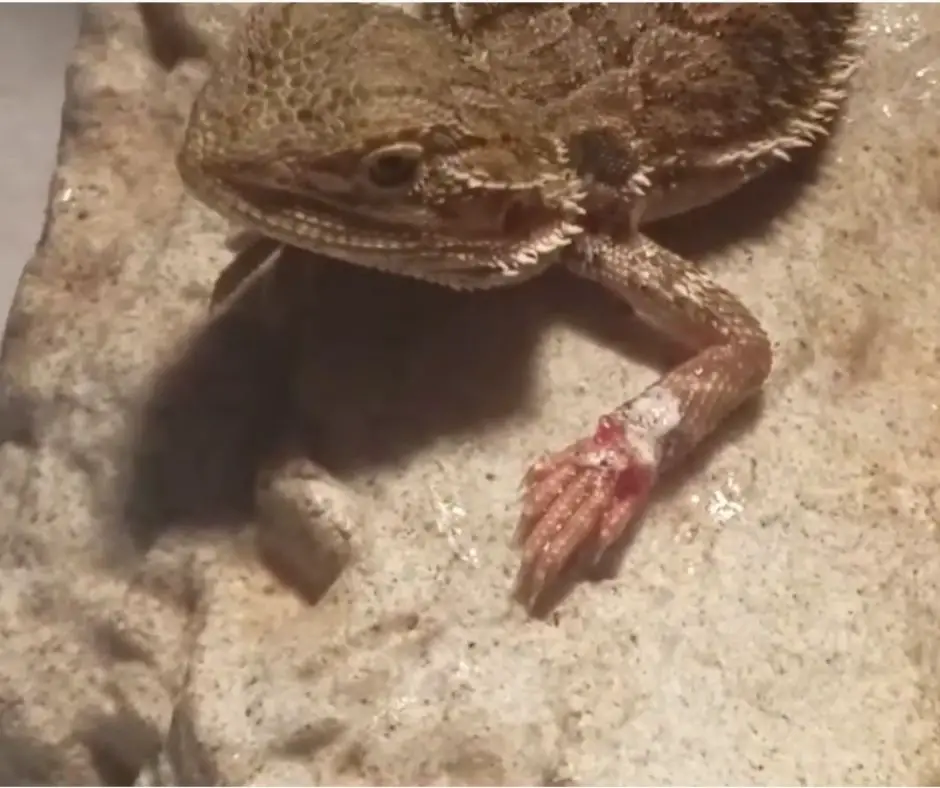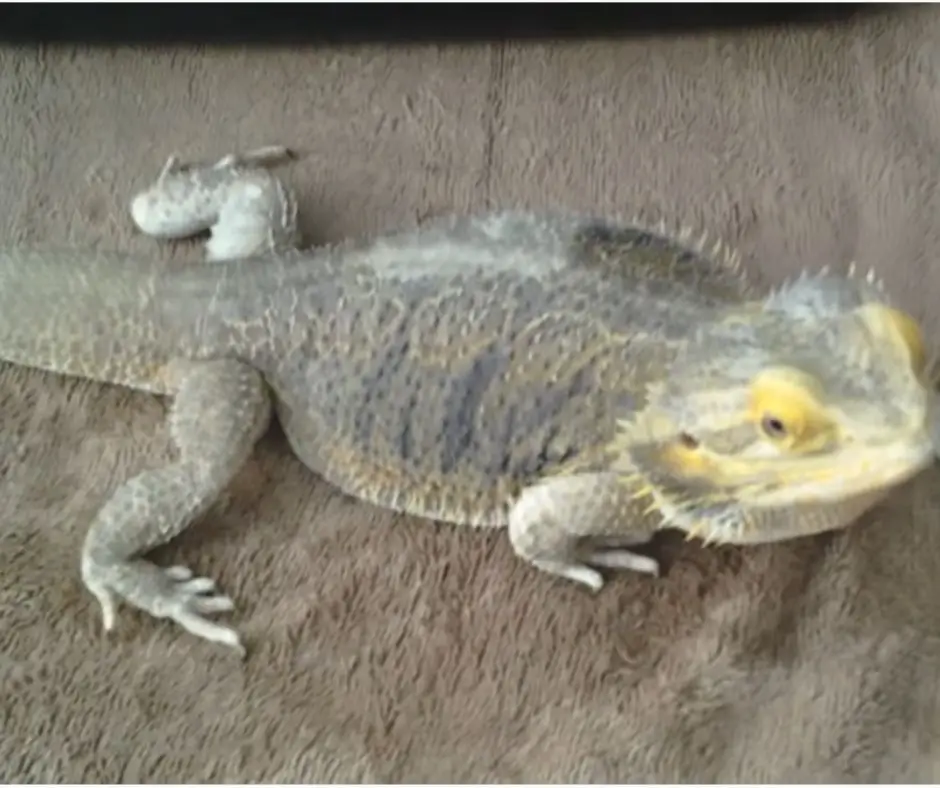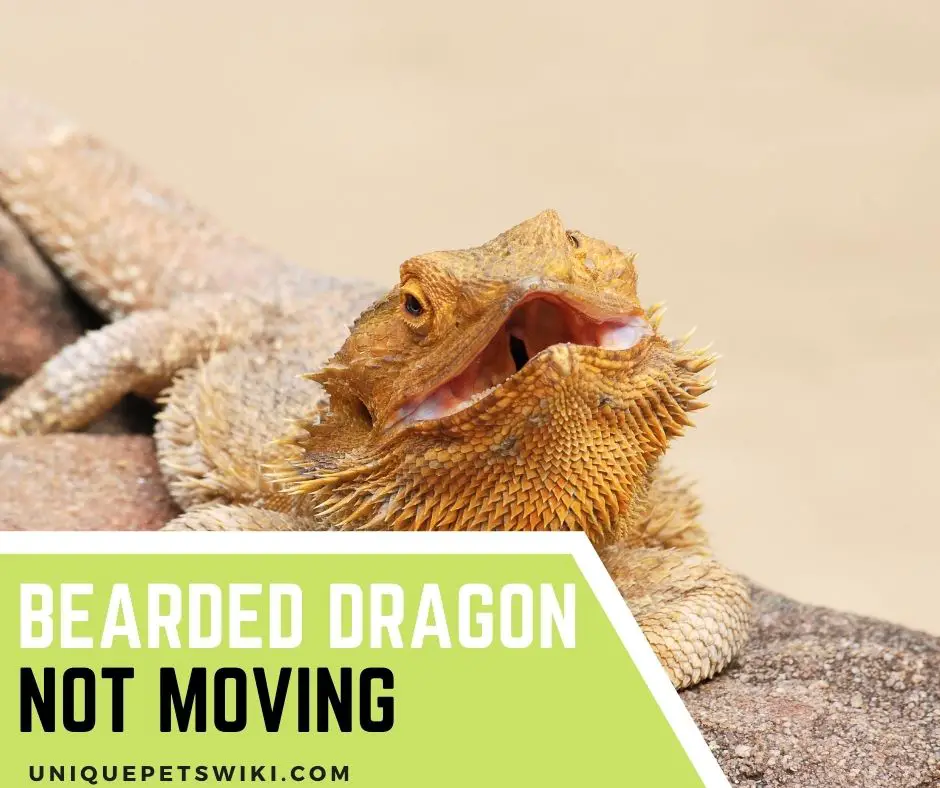It needs an act of courage and discernment for exotic pets to thrive in captivity. When verbal communication is not applicable, exotic pet owners study their pet’s behavior to differentiate between happy and sick.
Therefore, if you are a bearded dragon owner, it is critical to know when they are content or suffering. A bearded dragon not moving can be a sign of illness or stress.
This article highlights ten possible reasons that can lend your bearded dragon not moving. Also, we will tell you how to treat these causes.
You don’t want to miss out on this? Keep reading!
This article has been reviewed by Dr. Dilber. Read more about our knowledge control process here.
Contents
- 10 Common Cause Bearded Dragon Not Moving
- Your Bearded Dragon is Lazy
- Your Bearded Dragon Is Too Old
- The temperature in Cage is Too Cold
- Your Bearded Dragon Is Getting Ready to Brumate
- Your Bearded Dragon Injury Due to a Fall or Fight
- Your Bearded Dragon Paralysis Due to Impaction
- Your Bearded Dragon Retain Shed
- Sign of Possible Metabolic Disease
- Your Bearded Dragon is Suffering From Infectious Stomatitis Disease
- Worst Thing: Your Bearded Dragon is Dying
- Wrapping Up
10 Common Cause Bearded Dragon Not Moving
A bearded dragons not moving can be normal behavior, especially during the winter months.
However, it can also be a dangerous sign indicating stress or illness. Therefore, every bearded dragon owner must find the underlying cause of their pet’s immobility.
This section gives you a list of ten reasons that could make your dragon stop moving.
Your Bearded Dragon is Lazy
It is usual for bearded dragons to have their lazy days. Like humans, bearded dragons can also get moody and lazy around for one or two days.
Even so, prolonged lazing around can be a sign of improper habitation or illness. Therefore, before ruling out the reason for your bearded dragon to stay immobile is due to their laziness, you should ensure that they are healthy and in proper housing conditions.
Inadequate temperatures in your bearded dragon’s cage can make them act lazy or lethargic.
Other Accompanying Symptoms
The bearded dragon spends the entire day sleeping and only wakes up to feed. Some bearded dragons don’t even wake up to feed unless you disturb them.
They may also show other symptoms such as:-
- Eating less
- Hiding in the shades
- Sleeping early
- Defecating less
What Should Owners Do In This Situation?
If your bearded dragon seems to be lazing around, you should ensure they have a proper habitat and diet.
Also, you should consult an exotic vet to ensure that your bearded dragon is not suffering from any illness.
See what other bearded dragon owners say about their pet’s laziness in this forum.

Your Bearded Dragon Is Too Old
Bearded dragons are considered old once they hit 7-8 years. At this age, bearded dragons become weak and lethargic.
Therefore, it is normal for old bearded dragons to stop moving regularly and spend most of their time sleeping.
Other Accompanying Symptoms
Old bearded dragons will also have other accompanying symptoms such as:-
- Poor appetite
- Weak limbs
- Weight loss
- Loss of eyesight
- Stop breeding and laying eggs
- Lack of interest in chasing live bugs
- Lethargy

What Should Owners Do In This Situation?
Once your bearded dragon becomes a senior, it is necessary to take proper care for them to live longer and comfortably.
For instance, it is necessary to follow these feeding habits to keep your senior bearded dragon healthy.
- Provide a low calories diet.
- Offer them finely chopped food to prevent choking.
- Hand feeds your senior bearded dragon if it’s refusing to eat.
- Mist your senior bearded dragon’s nose or mouth several times a day to keep it hydrated.
- Provide a stress-free habitat
When the dragon gets older, it becomes susceptible to various health issues. its immune system becomes weak. So, it is vital to take proper care of dragon.
The temperature in Cage is Too Cold
Inadequate temperature is a significant factor that affects a bearded dragon’s movement.
When the temperature is too low, bearded dragons tend to become less active and may spend most of their time sleeping as they feel weak and lethargic.
Therefore, if your bearded dragon is not moving, it is commanding for you to check its cage temperature immediately.
Other Accompanying Symptoms
When your bearded dragon cage temperature is too low, you might also find your bearded dragon exhibiting other symptoms such as:-
- Indigestion
- Slow movement
- Failure to wake up
- Not defecating
What Should Owners Do In This Situation?
Inadequate temperature for some time can be fatal for bearded dragons. Therefore, it is necessary to provide adequate temperatures in your bearded dragon cage to keep them healthy and happy.
- Provide a basking temperature of 100-1050F, cooling spot 70-800F, Night temperature of 65-700F.
- Install digital thermometers at all spots to monitor the required temperatures.
Your Bearded Dragon Is Getting Ready to Brumate
During winter, cold-blooded animals such as bearded dragons adapt into a hibernation-like state to cope with the dropped temperatures.
They spend most of their time sleeping while hiding in the caves during this period.
It is usual for a bearded dragon to stop moving or significantly stay inactive. While in this state, they may also;-
Other Accompanying Symptoms
- Lose their appetite
- Burrow to create hides
- Spend less time in basking spots
- Stay hidden in cool areas for long hours
What Should Owners Do In This Situation?
- Let your beardie rest without disturbing it.
- Bath your beardie to help them with bowel movement.
- Gradually reduce the UV light and heat until you ultimately turn it off.
Your Bearded Dragon Injury Due to a Fall or Fight
Fall or fight injuries are common accidents in bearded dragons. Either injury can cause a bone fracture, internal bleeding, or severe pain rendering your bearded dragon stop moving.
Since bearded dragons have no way to communicate their pain, they may seem less active and pale.
Therefore, if your bearded dragon suddenly stops moving, you must examine them physically to check for any injury.

| Credit: juan Antonio / YouTube
Other Accompanying Symptoms
- Fast breathing
- Constipation
- Paralysis in the lower body
- Abdomen enlargement
- Bleeding from the mouth
- Lethargy
- Loss of appetite
What Should Owners Do In This Situation?
Fall or fight injuries can be fatal for bearded dragons. It is, therefore, vital to consider them severe and treat them with an emergency.
If you find your bearded dragon injured, you should:-
- Identify the cause of injury.
- Seek medical attention from a vet professional.
- Keenly follow the medical advice from the professional.
Your Bearded Dragon Paralysis Due to Impaction
Impaction is a common issue in most bearded dragons, and it comes as a result of a blockage in the digestive system.
Unfortunately, it is a dangerous condition that not only causes paralysis in bearded dragons but can also kill them.
Dangerous substrate, improper temperatures, and bad food are the primary causes of impaction in bearded dragons.
Therefore, every bearded dragon owner needs to provide a good diet, proper temperature, and an excellent substrate to their bearded dragons.

| Credit: The Nostradante Show / YouTube
Other Accompanying Symptoms
When your bearded dragon is experiencing impaction, you could also observe these other symptoms.
- Regurgitation
- Difficulty in bowel movement
- Dragging back legs as impaction causes paralysis in them
- Slight leg trembling
- Inability to walk properly
- A slight bump around the spinal
What Should Owners Do In This Situation?
Impaction can be fatal if left unattended. Therefore, it is necessary to take immediate measures to save your bearded dragon.
Here is a list of things that might help bearded dragons in case of impaction.
- Give your bearded dragon a warm bath.
- Gently massage your bearded dragon downwards to the vent
- Immediately consult an exotic pet vet for proper treatment.
Your Bearded Dragon Retain Shed
Shedding is a normal process in bearded dragons. Even so, the process causes them to use a significant amount of energy, rendering them weak and lethargic. Shedding is the process of renewing the tissues and cells. So, it requires energy which comes from body fats and diet.
It is, therefore, normal for bearded dragons to decrease their movement during the shedding process.
Other Accompanying Symptoms
Look out for these more signs if you suspect that your bearded dragon suffers from a retaining shed.
- Loss of appetite
- Bulging eyes
- Incomplete shed
- A bearded dragon may appear pale
- Rubbing against hard objects
What Should Owners Do In This Situation?
If you suspect that bearded dragon is experiencing retained shed, you should:-
- Offer your bearded dragon a proper diet that is rich in calcium.
- Check whether the UVB is providing adequate temperatures.
- Place bumpy objects in your bearded dragon’s cage to help them rub against them.
- Bath, your bearded dragon
- Mist your dragon and cage to increase humidity
- Use shedding aids and oil to soften the stuck shed
Sign of Possible Metabolic Disease
Metabolic disease is a nutrient deficiency illness that affects bearded dragons when they lack UVB exposure or Vitamin D3 in their diet. It highly affects bearded dragons’ legs and makes them extremely weak to walk or lift themselves barely.
Therefore, the metabolic disease is a common cause of immobility in bearded dragons.
Other Accompanying Symptoms
The metabolic disease commonly affects dragons’ bones, especially joints, making them weak. Other accompanying symptoms include
- Swelling of the lower jaw
- The soft lower jaw and facial bones
- Swelling of the hind limbs
- Trembling legs when walking
- Muscle twitching
- Seizure
- Lost appetite
- Lethargy
What Should Owners do in This Situation?
The metabolic disease comes from the improper diet, such as feeding your bearded dragons with a high in phosphorous than calcium diet.
Therefore, to prevent and treat metabolic disease, you should:-
- Ensure to provide a diet that is high in calcium rather than phosphorus. The ratio of calcium to phosphorus should be 2:1 at all times.
- Provide adequate UVB lighting in your bearded dragon’s cage to help them acquire Vitamin D3 in their skin.
- Immediately seek medical attention if your bearded dragon is suffering from any symptoms of metabolic disease.
Your Bearded Dragon is Suffering From Infectious Stomatitis Disease
Infectious stomatitis is not very common in bearded dragons as in other lizards. However, it is also a possible cause affecting the dragon’s mobility due to a lack of strength.
It affects bearded dragons’ mouths, making them refuse to eat. As a result, they become weak and less active.
Other Accompanying Symptoms
- Gum swelling
- Cottage-like mouth or nasal discharge
- Oral cavity lesions
- Loss of appetite
- Red tissue in the mouth
What Should Owners do in This Situation?
- Provide adequate temperature and humidity in your bearded dragon’s cage
- Provide a proper diet
- Regularly clean your pet’s cage to maintain proper hygiene.
- Immediately consult a vet for proper treatment.
Worst Thing: Your Bearded Dragon is Dying
Your bearded dragon not moving can be a danger sign when it’s dying. Many reasons can kill your bearded dragons, including
- Metabolic disease
- Egg binding
- Impaction
- Infection
- Organ failure
- Stress
- Ingestion of toxic plants
- Inadequate temperatures
Other Accompanying Symptoms
- Shallow breathing
- Lack of appetite
- Sunken or droopy eyes
- Dull or grey skin
- Lethargy
- Inactiveness
What Should Owners do in This Situation?
If your bearded dragon is dying, you may not be in a position to help it much. However, it would be best to ask a vet doctor to perform an autopsy to determine the cause of death.
Are you referring to the worst-case scenario? Maybe the bearded dragon is about to die? Signs My Bearded Dragon Is Dying
Wrapping Up
Bearded dragons are hardy and incredible creatures. Keeping them happy and thriving in captivity is not difficult. All you have to do is understand their usual behavior and determine any possible cause of their change in character.
This way, you can tell when they are not okay and act accordingly. We hope this article will help you keep your bearded dragon healthy and happy.
